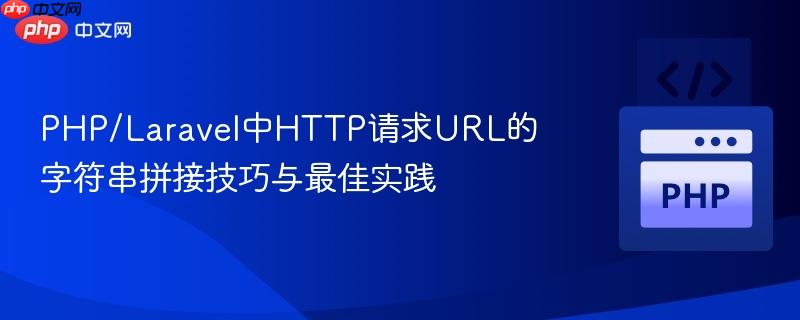
本文旨在详细探讨在php/laravel开发中,如何高效且规范地拼接http请求url中的字符串。我们将介绍三种主要的字符串拼接方法:字符串插值、连接运算符和`sprintf()`函数,并通过实例代码展示它们的应用。此外,还将重点讲解变量作用域的管理,特别是在laravel控制器中声明和使用类属性的最佳实践,以提升代码的可读性和维护性。
在进行外部HTTP请求时,构建动态的URL是常见的开发需求,尤其是在与RESTful API交互时。PHP提供了多种灵活的方式来拼接字符串,以构建完整的请求URL。理解并恰当运用这些方法,结合良好的变量管理,能够显著提升代码的清晰度和可维护性。
以下是PHP中构建动态URL的几种主要方法,它们各有特点,适用于不同的场景。
当使用双引号"定义字符串时,PHP会自动解析其中的变量。为了提高可读性,特别是当变量名可能与周围文本混淆或需要访问对象/数组属性时,可以使用花括号{}将变量包裹起来。
特点:
立即学习“PHP免费学习笔记(深入)”;
示例:
<?php
namespace App\Http\Controllers;
use Illuminate\Http\Request;
use Illuminate\Support\Facades\Http;
class ProjectController extends Controller
{
private string $baseUrl = 'https://api.nomics.com/v1/currencies/ticker?key=';
private string $apiKey = 'df87f0731def2f83a8539a2735b4c31ee';
public function getData(Request $request)
{
// 使用字符串插值构建URL
$url = "{$this->baseUrl}{$this->apiKey}&interval=1d,30d&convert=USD&per-page=100&page=1";
$response = Http::get($url);
return view('index', ['response' => $response->json()]);
}
}在上述示例中,{$this->baseUrl}和{$this->apiKey}清晰地指示了要插入的类属性。
连接运算符是PHP中最基础和直接的字符串拼接方式。它通过点号.将多个字符串和变量连接起来。
特点:
立即学习“PHP免费学习笔记(深入)”;
示例:
<?php
namespace App\Http\Controllers;
use Illuminate\Http\Request;
use Illuminate\Support\Facades\Http;
class ProjectController extends Controller
{
private string $baseUrl = 'https://api.nomics.com/v1/currencies/ticker?key=';
private string $apiKey = 'df87f0731def2f83a8539a2735b4c31ee';
public function getData(Request $request)
{
// 使用连接运算符构建URL
$url = $this->baseUrl . $this->apiKey . '&interval=1d,30d&convert=USD&per-page=100&page=1';
$response = Http::get($url);
return view('index', ['response' => $response->json()]);
}
}sprintf() 函数允许使用格式化字符串来构建输出。它接受一个格式字符串和一系列要插入的值。格式字符串中的占位符(如%s表示字符串)会被后续参数替换。
特点:
立即学习“PHP免费学习笔记(深入)”;
示例:
<?php
namespace App\Http\Controllers;
use Illuminate\Http\Request;
use Illuminate\Support\Facades\Http;
class ProjectController extends Controller
{
private string $baseUrl = 'https://api.nomics.com/v1/currencies/ticker?key=';
private string $apiKey = 'df87f0731def2f83a8539a2735b4c31ee';
public function getData(Request $request)
{
// 使用sprintf()构建URL
$url = sprintf(
'%s%s&interval=1d,30d&convert=USD&per-page=100&page=1',
$this->baseUrl,
$this->apiKey
);
$response = Http::get($url);
return view('index', ['response' => $response->json()]);
}
}sprintf()方法在处理复杂或多变量的URL时,能够提供更好的结构化和可读性。
在Laravel控制器中,正确管理变量的作用域至关重要。将API密钥或基础URL等配置信息作为类属性(private或protected)进行声明,是推荐的做法。
优点:
示例:
<?php
namespace App\Http\Controllers;
use Illuminate\Http\Request;
use Illuminate\Support\Facades\Http;
class ProjectController extends Controller
{
// 将基础URL和API密钥声明为私有类属性
private string $baseUrl = 'https://api.nomics.com/v1/currencies/ticker?key=';
private string $apiKey = 'df87f0731def2f83a8539a2735b4c31ee';
public function getData(Request $request)
{
// 在方法中使用$this->访问类属性
$url = sprintf(
'%s%s&interval=1d,30d&convert=USD&per-page=100&page=1',
$this->baseUrl,
$this->apiKey
);
$response = Http::get($url);
// 使用compact()函数简化视图数据传递
return view('index', compact('response'));
}
}注意事项:
在PHP/Laravel中构建HTTP请求URL时,开发者可以根据具体需求选择字符串插值、连接运算符或sprintf()函数。字符串插值简洁直观,连接运算符灵活基础,而sprintf()则在格式化复杂字符串时表现出色。同时,遵循良好的编程实践,如将配置信息作为类属性进行管理,并注意敏感信息的处理和URL编码,将有助于编写出更健壮、可维护且安全的应用程序。选择最适合当前场景的方法,并保持代码风格的一致性,是提升开发效率和代码质量的关键。
以上就是PHP/Laravel中HTTP请求URL的字符串拼接技巧与最佳实践的详细内容,更多请关注php中文网其它相关文章!

PHP怎么学习?PHP怎么入门?PHP在哪学?PHP怎么学才快?不用担心,这里为大家提供了PHP速学教程(入门到精通),有需要的小伙伴保存下载就能学习啦!

Copyright 2014-2025 https://www.php.cn/ All Rights Reserved | php.cn | 湘ICP备2023035733号